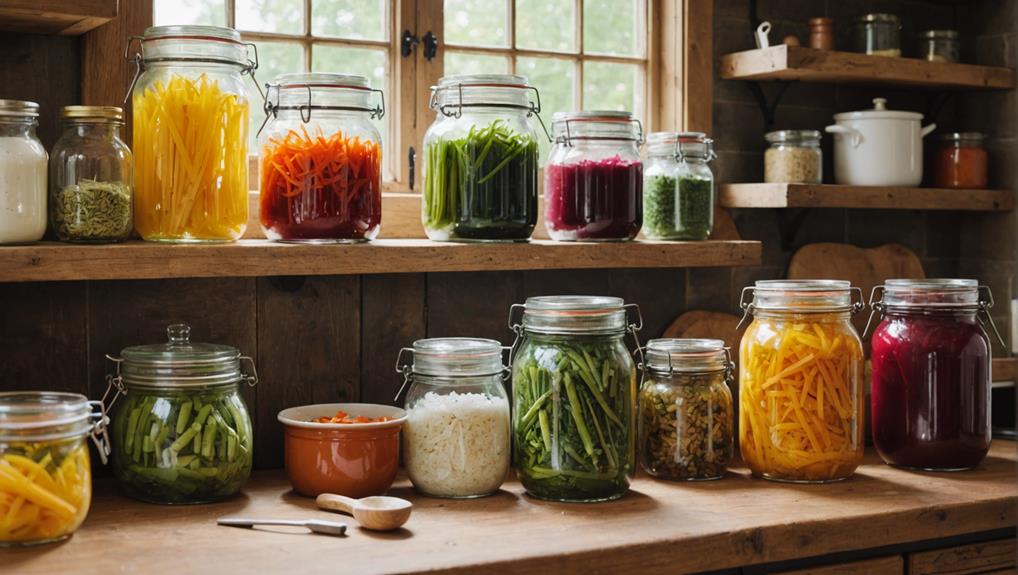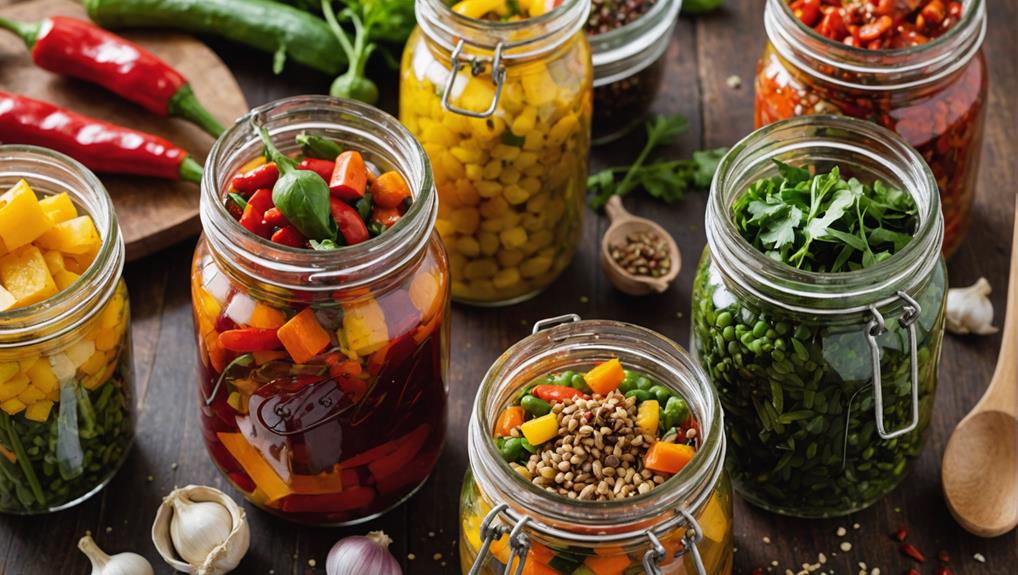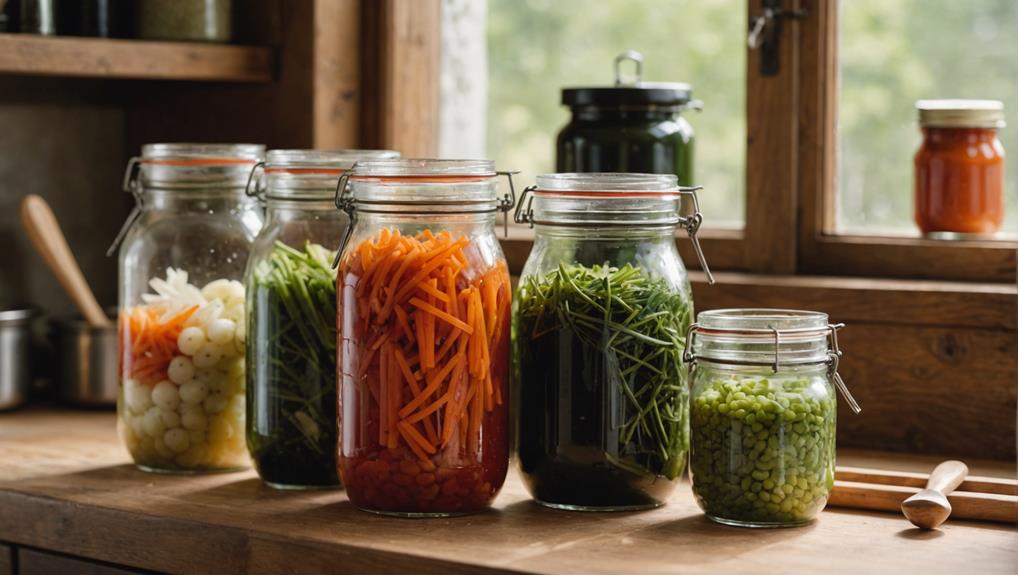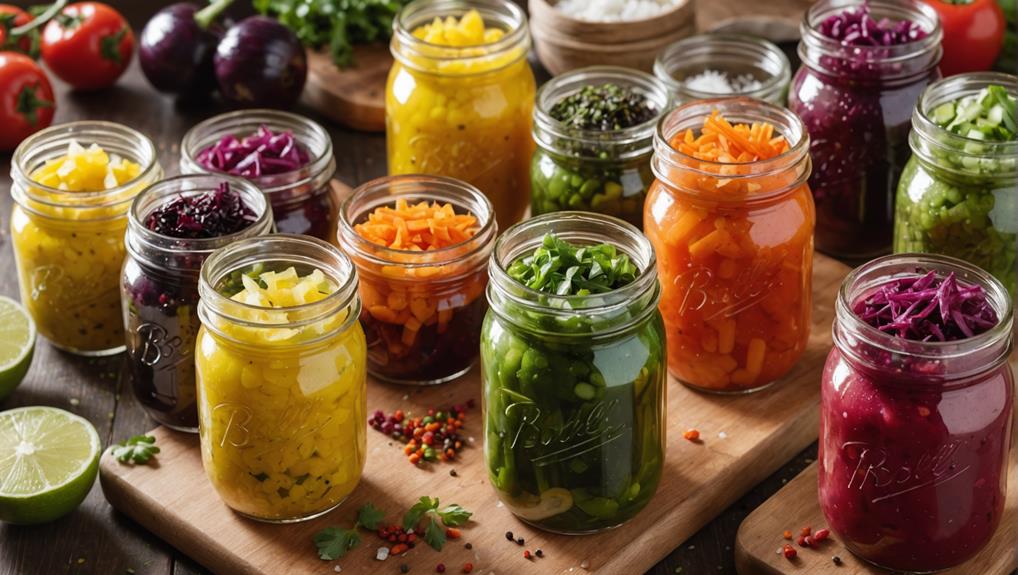To unlock fermentation's flavor-enhancing potential, start with the basics: clean equipment, quality ingredients, and precise measurements. Control your environment by maintaining temperatures between 65°F and 75°F for optimal microbial growth. Use salt concentrations of 2-5% to manage fermentation and create brine. Experiment with starter cultures or embrace wild fermentation for unique tastes. Incorporate fermented foods as condiments or flavor boosters in various dishes to add depth and complexity. Monitor the process closely, watching for signs of successful fermentation like bubbling and pleasant aromas. By mastering these techniques, you'll elevate your culinary repertoire and impress with your newfound fermentation skills.
Understanding the Fermentation Process
What's the secret behind the tangy bite of sauerkraut or the complex flavors of a well-aged cheese? It's all in the fermentation process, a fascinating metabolic transformation that's been part of culinary traditions for millennia.
When you're delving into fermentation techniques, you're harnessing the power of microorganisms such as bacteria, yeast, and molds to convert carbohydrates into alcohol, acids, or gases. This process occurs in anaerobic conditions, without oxygen, and can take anywhere from hours to months.
As a home cook, you'll need to master temperature control to ensure successful fermentation. Different types of fermentation yield unique flavors and aromas. Lactic acid fermentation gives you tangy yogurt and sauerkraut, while ethanol fermentation produces beer and wine.
The health benefits of fermented foods are numerous, thanks to the beneficial bacteria and enhanced nutrient profiles. To start your fermentation journey, focus on proper sanitation of equipment and ingredients.
Monitor your fermentation environment closely to maintain optimal conditions for microbial activity. By understanding these fundamentals, you'll unlock a world of complex tastes and innovative culinary possibilities.
Essential Tools and Ingredients
Now that you've grasped the basics of fermentation, it's time to equip your kitchen for success. Essential tools for your fermentation journey include glass jars with airtight lids, fermentation weights, and pH strips to monitor acidity levels.
You'll also need high-quality ingredients like organic vegetables and sea salt, preferably non-iodized. Don't forget to invest in starter cultures such as whey or commercial probiotic powders to kickstart your fermentation methods.
To maintain optimal conditions for microbial activity, consider temperature-controlled environments like fermentation crocks or dedicated refrigerators. These help keep temperatures between 60°F and 75°F (15°C to 24°C), ensuring ideal fermentation.
Elevate your creations by incorporating spices and flavorings such as garlic, ginger, and chili peppers, which enhance taste profiles and create unique flavor combinations.
Lastly, a reliable scale is crucial for measuring salt accurately. Aim for a 2-3% salt concentration relative to your vegetables' total weight to prevent spoilage.
With these tools and ingredients at your disposal, you're well-equipped to embark on your fermentation adventure and innovate in your kitchen.
Creating the Perfect Environment

To create the perfect fermentation environment, you'll need to master three key elements.
First, maintaining the right temperature range is crucial for encouraging beneficial microorganisms to thrive.
Second, you'll want to achieve the optimal salt concentration, which varies depending on your specific ferment but plays a vital role in controlling the microbial activity.
Temperature Control Essentials
Fermentation's success hinges on creating the perfect environment, with temperature control being a critical factor. To achieve optimal growth of beneficial microorganisms, maintain a consistent temperature between 65°F to 75°F (18°C to 24°C). This range promotes the development of complex flavors while inhibiting harmful bacteria.
For lactic acid fermentation, be cautious not to exceed 85°F (29°C), as this can lead to spoilage.
To effectively manage temperature, invest in fermentation jars with built-in thermometers or create a dedicated fermentation chamber. You can even use your oven with the light on for a controlled environment.
If you're aiming for slower fermentation and more intricate flavors, cooler temperatures around 50°F to 60°F (10°C to 15°C) are ideal for certain foods like pickles and cheese.
Don't overlook humidity levels, as they play a crucial role in the fermentation process. A too-dry environment can encourage mold growth, while excessive moisture may dilute flavors and promote undesirable fermentation.
Optimal Salt Concentration
After mastering temperature control, you'll need to focus on another key factor in creating the perfect fermentation environment: salt concentration. The optimal salt concentration for fermentation typically ranges from 2% to 5% of the total vegetable weight. This balance promotes the growth of beneficial lactic acid bacteria while inhibiting harmful microorganisms.
Salt plays a crucial role in drawing out moisture from vegetables, creating a brine that submerges the ingredients and establishes an anaerobic environment essential for successful fermentation.
To achieve the best results, consider these key points:
- Use kosher or sea salt, as they don't contain anti-caking agents that can interfere with the fermentation process.
- Precise measurement is crucial; too little salt (below 2%) may lead to spoilage, while too much (above 5%) can slow down fermentation.
- Taste the brine before fermentation to ensure a pleasant flavor, as it will mellow during the process.
- The salt concentration contributes to the overall flavor profile of the finished product.
Anaerobic Conditions Matter
Creating the perfect anaerobic environment is arguably the most critical step in successful fermentation. As a home cook eager to elevate your flavors, you'll need to master this crucial aspect. Anaerobic conditions, where oxygen is absent, allow beneficial microorganisms like yeasts and bacteria to thrive, preventing spoilage and promoting desired fermentation processes.
To achieve ideal anaerobic conditions, use airtight containers or fermentation lids that seal tightly. These prevent oxygen from entering while allowing gases produced during fermentation to escape.
Maintain a consistent temperature between 65°F to 75°F (18°C to 24°C) for optimal microbial activity and flavor development. Monitor pH levels throughout the process; a drop in pH indicates successful fermentation and lactic acid production.
Don't forget the power of salt in your fermentation journey. Adding salt not only enhances flavors but also creates an osmotic environment that inhibits harmful bacteria, further supporting anaerobic fermentation.
Harnessing Beneficial Microorganisms
To harness beneficial microorganisms in your fermentation projects, you'll need to master the art of selecting starter cultures and implementing environmental control techniques.
Your choice of starter culture, whether it's a commercial product or a wild fermentation approach, will significantly impact the flavor and health benefits of your fermented foods.
Selecting Starter Cultures
One of the most crucial steps in successful fermentation is selecting the right starter culture. These microorganisms kickstart the fermentation process, transforming your ingredients into flavorful, probiotic-rich foods.
To choose the best starter culture for your project, consider the following factors:
- The type of food you're fermenting
- The desired flavor profile and texture
- The optimal temperature and environmental conditions
- Your preferred method (commercial cultures or natural fermentation)
Lactic acid bacteria, like Lactobacillus, are excellent for vegetable and dairy ferments, while yeasts like Saccharomyces cerevisiae are ideal for bread and alcoholic beverages.
Each strain imparts unique characteristics to your final product, so it's essential to match the culture to your desired outcome.
You can source starter cultures from specialty stores, online retailers, or homebrew shops.
Alternatively, embrace natural fermentation by capturing wild microorganisms from your environment. This method adds an element of local terroir to your creations.
Environmental Control Techniques
Throughout the fermentation process, mastering environmental control techniques is essential for harnessing beneficial microorganisms and achieving consistent, high-quality results.
To revolutionize your fermentation game, focus on temperature regulation by maintaining an optimal range of 65°F to 75°F (18°C to 24°C). This sweet spot promotes the growth of beneficial bacteria while inhibiting harmful ones.
Create anaerobic conditions using airtight containers or fermentation weights to minimize oxygen exposure and encourage lactic acid bacteria growth.
Pay attention to salt concentration, aiming for 2-3% of your vegetable weight to draw out moisture and inhibit undesirable bacteria. Regularly monitor pH levels, targeting a range of 3.5 to 4.5 to ensure desirable flavors and safety.
Consider using starter cultures to kickstart the fermentation process. Introduce commercially available probiotic powders or whey from yogurt to ensure a robust population of beneficial microorganisms.
By implementing these innovative environmental control techniques, you'll unlock the full potential of fermentation, elevating your culinary creations to new heights.
Enhancing Flavor Profiles

How does fermentation transform ordinary ingredients into flavor powerhouses? This age-old process enhances the flavor of foods by producing complex compounds through microbial activity.
When you're fermenting at home, you're unlocking a world of unique flavors that can elevate your culinary creations. The magic of fermentation lies in its ability to develop depth and complexity, often introducing an umami taste that's hard to achieve through other cooking methods.
To harness the power of fermentation in your kitchen, consider these techniques:
- Experiment with lactic acid fermentation for tangy, sour notes
- Explore wild fermentation to introduce diverse microbial cultures
- Use fermented ingredients as flavor boosters in various dishes
- Combine different fermented foods to create layered flavor profiles
Maximizing Nutritional Benefits
Three key factors make fermented foods nutritional powerhouses. First, they're rich in probiotics, which support gut health and enhance nutrient absorption.
Second, the fermentation process increases the bioavailability of nutrients, making vitamins and minerals more accessible to your body.
Third, fermented foods contain beneficial compounds like short-chain fatty acids that regulate metabolism and promote satiety.
To maximize the nutritional benefits of fermented foods, incorporate a variety of them into your diet. This diversity enhances your gut microbiome, which is crucial for a healthy immune system and overall wellness.
You'll be reducing your risk of chronic diseases like heart disease and type 2 diabetes, thanks to the anti-inflammatory properties of fermented foods.
When preparing fermented foods at home, focus on using high-quality ingredients and maintaining proper fermentation conditions. This ensures you're getting the most nutritional value from your efforts.
Remember, the longer the fermentation process, the more probiotic bacteria develop, potentially increasing the health benefits.
Troubleshooting Common Issues

Navigating the world of fermentation can sometimes feel like a bumpy ride, but don't worry—most issues have simple solutions.
When troubleshooting common issues in fermenting food, it's crucial to monitor the process closely and use high-quality ingredients. If your fermentation isn't bubbling, check the temperature and ensure your yeast or bacteria are active.
For cloudy or murky appearances, focus on proper sanitation of equipment to prevent wild yeast or bacteria growth.
To address flavor and texture concerns:
- Overly sour taste: Your ferment may have gone too long. Taste regularly to achieve desired flavors.
- Too salty: Dilute with fresh unsalted brine or mix with other ingredients.
- Off-putting smell: This could indicate spoilage. Discard and start fresh.
- Lack of bubbling: Verify temperature (60-75°F) and yeast/bacteria activity.
Exploring Culinary Applications
Fermented foods offer a world of culinary possibilities for home cooks. By incorporating fermented vegetables and other fermented ingredients into your dishes, you'll unlock a treasure trove of flavors and health benefits.
Start by adding a little kimchi to your stir-fries or a spoonful of miso to your soups for an instant umami bomb. These simple additions can transform ordinary meals into extraordinary culinary experiences.
Experiment with acid fermentation to create your own pickles or sauerkraut, enhancing your culinary skills while preserving food. These homemade ferments not only add depth to your dishes but also contribute to healthy eating by introducing beneficial probiotics.
Don't be afraid to use fermented ingredients as condiments or flavor enhancers in unexpected ways. A splash of kombucha in your salad dressing or a dollop of yogurt in your curry can elevate the taste profile and create a more balanced dish.
Remember that fermentation introduces acidity, which can cut through rich, fatty flavors, resulting in a more complex and satisfying meal. By mastering these fermentation secrets, you'll expand your culinary repertoire and impress your dinner guests with innovative, flavorful creations.
Frequently Asked Questions
What Is the Secret Ingredient That Helps All Food Taste Better?
You'll elevate any dish by mastering seasoning strategies and flavor pairings. Experiment with umami boosters, innovative ingredient swaps, and diverse cooking methods. Explore global culinary traditions to broaden your taste profile repertoire and unlock new flavor dimensions.
How Does Fermentation Enhance Flavor?
You'll discover fermentation enhances flavor by creating umami richness and flavor complexity. It's a preservation method with probiotic benefits, rooted in cultural traditions. Various fermentation types offer unique sensory experiences, revolutionizing your culinary adventures with innovative taste profiles.
What Elevates the Taste of Food?
You'll elevate your food's taste by mastering umami boosters, seasoning balance, and acidity levels. Don't overlook ingredient freshness and innovative cooking methods. Experiment with unexpected flavor pairings and texture contrasts to create exciting, memorable dishes that tantalize the palate.
Who Should Not Eat Fermented Foods?
Ironically, not everyone can enjoy the health-boosting fermented foods craze. You shouldn't indulge if you've got digestive issues, immune disorders, food allergies, or medication interactions. Those with sensitive stomachs or personal preferences may also want to avoid these innovative delicacies.
Final Thoughts
You've now unlocked the secrets of fermentation, a culinary alchemy that transforms ordinary ingredients into extraordinary flavors. Armed with these techniques, you're ready to embark on a journey of taste and discovery. As you experiment with different cultures and ingredients, you'll find your kitchen becoming a laboratory of delicious possibilities. Remember, patience is key in this process, but the rewards are well worth the wait. Embrace the art of fermentation, and watch your culinary creations soar to new heights.















